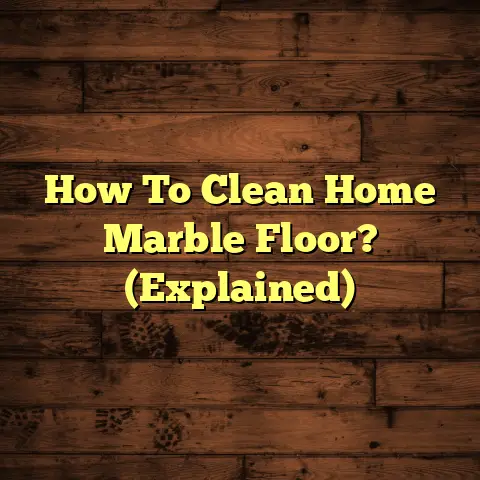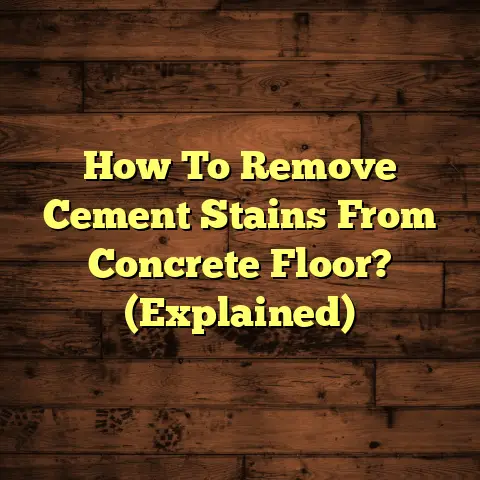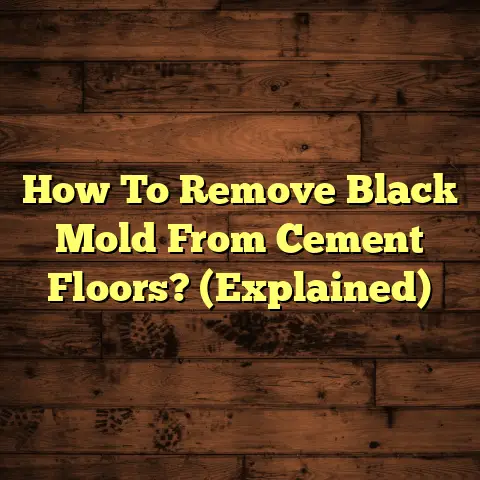Glue Hardwood To Concrete? (9 Prep Essentials!)
Did you know that over 50% of new homebuyers are choosing hardwood floors for that classic, timeless look?
Yep, according to a recent study by the National Association of Realtors, hardwood is the top choice.
But can you just slap those beautiful planks right onto concrete?
Well, not so fast.
Gluing hardwood to concrete can be a fantastic way to get that gorgeous hardwood look in basements or on concrete slabs.
But, trust me, skipping the prep work is a recipe for disaster.
I’ve seen it all – warping, buckling, adhesive failure – and believe me, you don’t want that headache.
So, let’s get into it!
Section 1: Understanding the Basics of Hardwood and Concrete Flooring
Okay, let’s break down what we’re working with.
What is Hardwood Flooring?
Hardwood flooring is, well, flooring made from wood!
But there are two main types you need to know about:
Solid Hardwood: This is the real deal – planks made from a single piece of wood.
It’s beautiful, durable, and can be refinished multiple times.Engineered Hardwood: This is made of layers of wood with a hardwood veneer on top.
It’s more stable than solid hardwood and better at handling moisture, making it a great choice for concrete.
Concrete as a Flooring Base
Concrete is a super durable, common flooring base, especially in basements and ground-level homes.
It’s strong and can last for decades.
However, it’s also porous, meaning it can absorb moisture.
And moisture is hardwood’s worst enemy.
Advantages of Gluing Hardwood to Concrete
So, why glue hardwood to concrete in the first place?
-
Stability: When done right, gluing provides a super stable floor that won’t shift or move.
-
Moisture Control: With the right adhesive and vapor barrier, you can minimize moisture issues.
-
Ease of Installation: Compared to other methods, gluing can be a faster and easier way to install hardwood, especially for DIYers.
Section 2: The Importance of Preparation Before Installation
Let me tell you a story.
I once had a client who was so eager to get his new hardwood floors installed that he skipped most of the prep work.
Big mistake!
Within a few months, the floors started to warp and buckle.
He ended up having to rip everything out and start over, costing him time and money.
Preparation is everything.
It’s the foundation (literally!) for a successful, long-lasting hardwood floor.
Think of it this way: you wouldn’t build a house on a shaky foundation, right?
The same goes for your floors.
Proper preparation prevents future issues like:
- Warping
- Buckling
- Adhesive Failure
- Mold Growth
Trust me, taking the time to prep properly will save you a ton of headaches down the road.
Section 3: Essential Prep Step 1 – Moisture Testing
Moisture is the number one enemy when gluing hardwood to concrete.
Concrete is porous and can wick up moisture from the ground.
Excess moisture can cause the wood to expand, warp, and even rot.
That’s why moisture testing is absolutely crucial.
You need to test both the concrete slab and the hardwood itself.
How to Conduct Moisture Tests:
For Concrete:
Calcium Chloride Test (ASTM F1869): This is the gold standard.
You place a small container of calcium chloride on the concrete, seal it, and weigh it after a set period (usually 72 hours).
The weight gain indicates the moisture emission rate.-
Relative Humidity (RH) Test (ASTM F2170): This involves drilling small holes into the concrete and inserting probes to measure the relative humidity.
Electronic Moisture Meter: These meters give you a quick reading of the moisture content on the surface of the concrete.
While not as accurate as the other two methods, they’re useful for getting a general idea.
For Hardwood:
-
Pin Moisture Meter: This type of meter uses two pins that penetrate the wood to measure its moisture content.
-
Pinless Moisture Meter: This meter uses electromagnetic waves to measure moisture content without damaging the wood.
Acceptable Moisture Levels:
-
Concrete: Generally, you want moisture emission rates below 3 lbs per 1000 sq ft per 24 hours (Calcium Chloride Test) or RH levels below 75% (RH Test).
-
Hardwood: The ideal moisture content for hardwood is typically between 6% and 9%, but it depends on your local climate.
Pro Tip: I always recommend hiring a professional to conduct moisture tests.
They have the right tools and expertise to get accurate readings and interpret the results.
Section 4: Essential Prep Step 2 – Cleaning the Concrete Surface
Alright, you’ve got your moisture levels under control.
Now it’s time to get that concrete squeaky clean!
Think of your concrete slab as a giant sponge that has soaked up years of dust, dirt, and who-knows-what-else.
You need to remove all of that gunk to ensure the adhesive bonds properly.
Steps for Cleaning the Concrete:
-
Remove Existing Flooring: If there’s any old flooring or adhesive residue, scrape it off using a floor scraper or adhesive remover.
-
Sweep or Vacuum: Get rid of loose dirt and debris with a broom or vacuum cleaner.
Scrub with a Concrete Cleaner: Use a specialized concrete cleaner to remove grease, oil, and other stubborn stains.
Follow the manufacturer’s instructions carefully.-
Rinse Thoroughly: Rinse the concrete with clean water to remove any cleaner residue.
Allow to Dry Completely: This is crucial!
Make sure the concrete is completely dry before moving on to the next step.
Effective Cleaning Agents and Tools:
-
Concrete Degreaser: For removing oil and grease stains.
TSP (Trisodium Phosphate): A powerful cleaner for removing dirt and grime.
(Note: TSP can be harmful, so use it with caution and wear appropriate PPE.)-
Floor Scraper: For removing old flooring and adhesive.
-
Shop Vacuum: For removing dust and debris.
-
Stiff-Bristled Brush: For scrubbing the concrete.
My Go-To Cleaning Method:
Personally, I like to use a combination of a concrete degreaser and a good scrub brush.
I find that this gets the concrete really clean without damaging it.
Section 5: Essential Prep Step 3 – Leveling the Concrete Floor
Okay, imagine trying to build a house on a hill that’s not level.
It’s going to be a disaster, right?
The same goes for your hardwood floors.
A level surface is absolutely critical for a successful installation.
Even small dips and bumps can cause your floors to look uneven and feel uncomfortable underfoot.
Plus, an uneven surface can put stress on the adhesive, leading to premature failure.
Common Leveling Issues:
-
Dips and Low Spots: These are common in older concrete slabs.
-
Cracks and Holes: These can be caused by settling or damage.
-
Uneven Seams: If the concrete was poured in sections, the seams might not be perfectly level.
Solutions for Leveling:
Self-Leveling Compound: This is a liquid mixture that you pour onto the concrete.
It flows into the low spots and creates a perfectly level surface as it dries.-
Concrete Patching Compound: This is a thicker material that you can use to fill in cracks, holes, and small dips.
-
Grinding: For minor imperfections, you can use a concrete grinder to smooth out the surface.
How to Use Self-Leveling Compound:
-
Prime the Concrete: Apply a concrete primer to the surface to help the self-leveling compound bond properly.
-
Mix the Compound: Follow the manufacturer’s instructions carefully to mix the self-leveling compound.
-
Pour the Compound: Pour the compound onto the concrete, starting in the deepest areas.
-
Spread the Compound: Use a gauge rake or trowel to spread the compound evenly.
-
Allow to Dry: Let the compound dry completely according to the manufacturer’s instructions.
A Word of Caution:
Working with self-leveling compound can be tricky.
If you’re not comfortable doing it yourself, I recommend hiring a professional.
Section 6: Essential Prep Step 4 – Acclimating the Hardwood
Imagine taking a cold glass of water outside on a hot summer day.
What happens?
Condensation forms on the glass as the water warms up.
The same thing happens with hardwood.
Wood is a natural material that expands and contracts with changes in temperature and humidity.
If you install hardwood before it has a chance to acclimate to the room’s environment, it can warp, buckle, or shrink after installation.
Acclimating the hardwood is the process of allowing it to adjust to the room’s temperature and humidity before you install it.
This helps to minimize any movement after installation.
How to Acclimate Hardwood:
-
Bring the Hardwood into the Room: At least 3-5 days (or as recommended by the manufacturer) before installation, bring the hardwood into the room where it will be installed.
Stack the Planks Properly: Stack the planks in a way that allows air to circulate around them.
Crisscrossing the planks is a good method.-
Maintain Consistent Temperature and Humidity: Keep the room’s temperature and humidity as consistent as possible during the acclimation period.
Timeframe for Acclimation:
The amount of time it takes for hardwood to acclimate depends on several factors, including:
-
Type of Wood: Some woods acclimate faster than others.
-
Climate: In humid climates, it may take longer for wood to acclimate.
-
Thickness of Planks: Thicker planks take longer to acclimate.
Generally, I recommend acclimating hardwood for at least 3-5 days, but always follow the manufacturer’s recommendations.
My Acclimation Tip:
I like to use a dehumidifier or humidifier to control the room’s humidity during the acclimation period.
This helps to ensure that the wood acclimates evenly.
Section 7: Essential Prep Step 5 – Choosing the Right Adhesive
Alright, we’re getting closer to the fun part – actually installing the hardwood!
But before you start spreading adhesive, you need to make sure you’re using the right kind.
Not all adhesives are created equal.
Some are better suited for gluing hardwood to concrete than others.
The wrong adhesive can lead to a weak bond, which can cause your floors to shift, squeak, or even come loose.
Types of Adhesives for Hardwood to Concrete:
Urethane Adhesives: These are the most common type of adhesive for gluing hardwood to concrete.
They’re strong, flexible, and moisture-resistant.-
Modified Silane Polymer (MSP) Adhesives: These adhesives are similar to urethane adhesives, but they’re even more moisture-resistant and have low VOCs (volatile organic compounds).
-
Acrylic Adhesives: These adhesives are less expensive than urethane and MSP adhesives, but they’re not as strong or moisture-resistant.
Factors to Consider When Choosing an Adhesive:
-
Moisture Content of Concrete: If your concrete has high moisture content, you’ll need an adhesive that’s specifically designed for those conditions.
-
Type of Hardwood: Some woods are more difficult to bond than others.
-
Subfloor: If your concrete subfloor isn’t perfectly smooth, you’ll need an adhesive that can fill in the gaps.
My Adhesive Recommendation:
I generally recommend using a high-quality urethane or MSP adhesive for gluing hardwood to concrete.
They’re more expensive than acrylic adhesives, but they’re worth the investment for the added strength and moisture resistance.
Section 8: Essential Prep Step 6 – Installing a Vapor Barrier
We’ve talked a lot about moisture, and for good reason!
It’s the biggest threat to your hardwood floors when gluing to concrete.
A vapor barrier is a material that prevents moisture from seeping through the concrete and into the hardwood.
It’s like a raincoat for your floors.
Without a vapor barrier, moisture can cause the wood to warp, buckle, and even rot.
Types of Vapor Barriers:
-
Polyethylene Film: This is a thin plastic film that’s placed over the concrete before installing the hardwood.
-
Liquid-Applied Membrane: This is a liquid that’s applied to the concrete and forms a waterproof membrane when it dries.
-
Adhesive with Vapor Barrier Properties: Some adhesives have built-in vapor barrier properties, which can save you a step.
How to Install a Vapor Barrier:
-
Clean the Concrete: Make sure the concrete is clean and dry before installing the vapor barrier.
-
Apply the Vapor Barrier: Follow the manufacturer’s instructions for applying the vapor barrier.
-
Overlap the Seams: Overlap the seams of the vapor barrier by at least 6 inches.
-
Seal the Seams: Seal the seams with vapor barrier tape.
A Vapor Barrier Tip:
I always recommend using a high-quality vapor barrier, even if your concrete has low moisture content.
It’s better to be safe than sorry!
Section 9: Essential Prep Step 7 – Planning the Layout
Okay, you’ve prepped the concrete, chosen your adhesive, and installed a vapor barrier.
Now it’s time to start thinking about the layout of your hardwood planks.
The layout can have a big impact on the overall look and feel of your floors.
A well-planned layout can make a room look bigger, brighter, and more inviting.
Tips for Planning the Layout:
-
Consider the Light Source: Run the planks parallel to the main light source to minimize shadows and make the room look brighter.
-
Start with a Straight Line: Find the longest, straightest wall in the room and use it as your starting point.
-
Stagger the Seams: Stagger the seams of the planks to create a more visually appealing look.
-
Avoid Short Pieces: Try to avoid using short pieces of wood at the ends of rows.
-
Plan for Transitions: Plan for transitions between different types of flooring.
My Layout Secret:
I like to dry-lay a few rows of planks before I start gluing them down.
This allows me to get a feel for the layout and make any necessary adjustments.
Section 10: Essential Prep Step 8 – Gathering the Right Tools
Alright, you’re almost ready to start gluing those beautiful hardwood planks to the concrete!
But before you do, you need to make sure you have all the right tools.
Having the right tools will make the job easier, faster, and more efficient.
Essential Tools for Gluing Hardwood to Concrete:
Trowel: For spreading the adhesive.
Choose a trowel with the correct notch size for the adhesive you’re using.-
Spacers: For maintaining consistent spacing between the planks.
-
Rubber Mallet: For tapping the planks into place.
-
Measuring Tape: For measuring and marking the layout.
-
Saw: For cutting the planks to size.
-
Safety Glasses: For protecting your eyes.
-
Gloves: For protecting your hands.
-
Knee Pads: For protecting your knees.
My Tool Recommendation:
I always recommend investing in high-quality tools.
They’ll last longer and perform better than cheaper tools.
Section 11: Essential Prep Step 9 – Safety Precautions
Last but not least, let’s talk about safety.
Gluing hardwood to concrete can be a messy and potentially hazardous job.
It’s important to take the necessary precautions to protect yourself and others.
Safety Tips:
-
Wear Safety Glasses: Always wear safety glasses to protect your eyes from dust, debris, and adhesive.
-
Wear Gloves: Wear gloves to protect your hands from the adhesive.
-
Wear a Dust Mask: Wear a dust mask to protect your lungs from dust and fumes.
-
Ensure Adequate Ventilation: Work in a well-ventilated area to avoid breathing in harmful fumes.
-
Follow the Manufacturer’s Instructions: Always follow the manufacturer’s instructions for the adhesive and other materials you’re using.
A Safety Reminder:
Always err on the side of caution when it comes to safety.
It’s better to be safe than sorry!
Conclusion
So, there you have it!
Gluing hardwood to concrete can be a rewarding project.
But it’s super important to remember that proper preparation is absolutely essential for a successful installation.
By following these nine prep essentials, you can ensure that your floors look beautiful and last for years to come:
- Moisture Testing
- Cleaning the Concrete Surface
- Leveling the Concrete Floor
- Acclimating the Hardwood
- Choosing the Right Adhesive
- Installing a Vapor Barrier
- Planning the Layout
- Gathering the Right Tools
- Safety Precautions
I hope this article has been helpful.
Now go out there and create the hardwood floors of your dreams!
Happy flooring!





